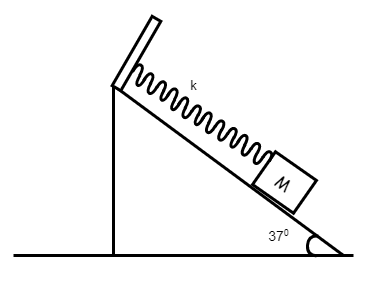Question
Question: The system of the wedge and the block connected by a massless spring as shown in the figure is relea...
The system of the wedge and the block connected by a massless spring as shown in the figure is released with the spring in its natural length. Friction is absent. Maximum elongation in the spring will be

A) 5k3Mg.
B) 5k6Mg.
C) 5k4Mg.
D) 5k8Mg.
Solution
For this question, we have to calculate the displacement of the block given which will give us the maximum elongation of the spring. Here as the body is placed in an inclined plane, we have to place the displacement and divide it into its components, the vertical component, and the horizontal component.
Complete step by step answer:
Here we have a block of mass M that is connected by a massless spring to a wedge as shown in the figure.
Now to find the maximum elongation we have to calculate the displacement of the block first.
So, the amount of potential energy lost by the block is the energy stored by the spring.
The force acting on the block is Mg. Now, this can be divided into its vertical and horizontal components as Mgcosθ and Mgsinθ. This gives us that the force acting on the block on the wedge will depend on Mgsinθ as this is the component of force acting in that direction.
Let us consider the block is displaced by x, then we can write,
Mgsinθ.x=21k.x2.
Now, equating we get,
Mgsinθ=21k.x.
This can be rewritten,
x=k2Mgsinθ.
Now, θ=370 this gives us,
sinθ=53.
Thus, x=k2Mg⋅53=5k6Mg .
So, the maximum elongation possible for the spring will be 5k6Mg.
Thus, the answer to this question is option (B).
Note: The most common mistake the students make in this problem is the use of force balance, i.e. they equate kx=Mgsinθ. This will give us displacement x=5k3Mg. This will be giving us the mean position of displacement. This is not the maximum elongation but the mean elongation.
